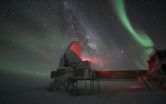(Press-News.org) JUPITER, FL, August 15, 2012 – Working with a national team of researchers, a scientist from the Florida campus of The Scripps Research Institute has shown for the first time a link between low levels of a specific hormone and increased risk of metabolic disease in humans.
The study, published online ahead of print in The Journal of Clinical Endocrinology & Metabolism, focuses on the hormone adropin, which was previously identified by Scripps Research Associate Professor Andrew Butler's laboratory during an investigation of obese and insulin-resistant mice. Adropin is believed to play an important role in regulating glucose levels and fatty acid metabolism.
"The results of this clinical study suggest that low levels of adropin may be a factor increasing risk for developing metabolic disorders associated with obesity and insulin resistance, which could then lead to diseases such as type 2 diabetes," said Butler, who led the new study with Peter J. Havel, professor of molecular biosciences and nutrition at the University of California, Davis.
Approximately 47 million adults in the United States have metabolic syndrome, according to the American College of Cardiology. The National Institutes of Health defines metabolic syndrome as a group of risk factors, especially obesity and insulin resistance, that occur together and increase the risk for coronary artery disease, stroke, and type 2 diabetes.
Intriguing Results
In the new study, which involved 85 women and 45 men, Butler and his colleagues showed that obesity is associated with lower adropin levels. Lower adropin levels were also observed in individuals with a higher "metabolic syndrome risk factor" score, a score determined by measuring triglycerides, LDL cholesterol, HDL, glucose, blood pressure, and waist circumference.
The scientists also observed circulating adropin concentrations increased significantly at three and six months following gastric bypass surgery in morbidly obese patients. Interestingly, adropin levels returned to pre-surgical levels at 12 months after surgery.
Another surprising finding of the new study was that in people of normal weight, women had lower plasma adropin levels than men. In addition, obesity had a bigger negative effect on adropin levels in men. Interestingly, obesity in woman was also not associated with lower plasma adropin levels. The significance of the differences between men and woman is unknown at the moment.
"But the link between low levels of adropin and increased metabolic risk was observed in both sexes," Butler said. "The impact is there, irrespective of gender."
Adropin levels were also found in general to decrease with age—the decline was highest in those over 30 years of age. As with obesity, the aging effect appeared to be more pronounced in men.
Findings in Humans Mirror Preclinical Work
The new study is an important extension of earlier pre-clinical studies using animal models published in the July edition of Obesity. In that study, Butler and colleagues deleted the gene encoding adropin from mice. The scientists found that, while normal in appearance, adropin-deficient mice have insulin resistance and, when fed diets with a high fat content, develop a more severe impaired glucose tolerance (IGT). These findings suggest reduced insulin production and attenuated response to insulin, which are the defining features of type 2 diabetes. Importantly, mice having only one functional copy of the gene encoding adropin also exhibited increased propensity for developing impaired glucose tolerance with obesity. These findings provided important pre-clinical evidence evidence that low levels of adropin are associated with increased risk of developing type 2 diabetes.
In other studies, Butler's laboratory observed that obese mice exhibit dramatic reductions in circulating adropin levels, and that insulin resistance was reversed after injections with a synthetic form of adropin.
"The data from these studies provide strong evidence suggesting that low levels of adropin may be an indicator of risk for insulin resistance in obesity and, consequently, an increased risk for metabolic diseases, including type 2 diabetes," Butler said. "We see a lot of similarity between animal model data and the new human data—low adropin levels in humans are associated with a host of metabolic syndrome risk factors normally associated with obesity and insulin resistance."
Taken together, these studies suggest the possibility that therapeutics designed to boost the supply of adropin might be useful in fighting obesity and metabolic disease.
INFORMATION:
In addition to Butler and Havel, authors of the study, "Low Circulating Adropin Concentrations With Obesity And Aging Correlate With Risk Factors For Metabolic Disease And Increase After Gastric Bypass Surgery In Humans," include Charmaine S. Tam and Eric Ravussin of Louisiana State University, Baton Rouge; Kimber L. Stanhope and Mohamed R. Ali of the University of California, Davis; Bruce M. Wolfe of the Oregon Health Sciences University, Portland; and Majella O'Keeffe and Marie-Pierre St Onge of Columbia University.
The study was supported by the National Institutes of Health (award numbers HL061352, DK060412, HL075675, HL09133, UL1 RR024156-03, UL1 RR024146, and 1P30 DK072476-06); the American Diabetes Association; The Novo Nordisk Diabetes Innovation Award Program; the University of California, Davis Health Care Systems Award; the Irving Center for Translational Science; and the Pennington Biomedical Research Center's Nutrition Obesity Research Center program.
Team uncovers link between hormone levels and risk for metabolic disease
The work may pave the way for new therapies for obesity and diabetes
2012-08-16
ELSE PRESS RELEASES FROM THIS DATE:
Giant galaxy cluster sets record pace for star creation
2012-08-16
Astronomers have found an extraordinary galaxy cluster — one of the largest objects in the universe — that is breaking several important cosmic records. The discovery of this cluster, known as the Phoenix Cluster, made with the National Science Foundation's South Pole Telescope, may force astronomers to rethink how these colossal structures, and the galaxies that inhabit them, evolve.
Follow-up observations made in ultraviolet, optical and infrared wavelengths show that stars are forming in this object at the highest rate ever seen in the middle of a galaxy cluster. The ...
Designing tiny molecules that glow in water to shed light on biological processes
2012-08-16
CORAL GABLES, FL (August, 15, 2012)--University of Miami scientists have developed a way to switch fluorescent molecules on and off within aqueous environments, by strategically trapping the molecules inside water-soluble particles and controlling them with ultraviolet light. The new system can be used to develop better fluorescent probes for biomedical research.
Previous studies have used water-soluble particles to bring organic molecules into water. What is novel about this system is the use of a photoswitching mechanism in combination with these particles.
The findings ...
NSF's South Pole Telescope discovers a galaxy cluster creating stars at a record pace
2012-08-16
A National Science Foundation-funded radio telescope in Antarctica has found an extraordinary galaxy cluster that may force astronomers to rethink how galaxy clusters and the galaxies that inhabit them evolve.
The galaxy cluster was discovered some 5.7 billion light years from Earth by the 10-meter wide South Pole Telescope (SPT) located at NSF's Amundsen-Scott South Pole Station in Antarctica, which is funded by NSF's Office of Polar Programs.
NSF manages the U.S. Antarctic Program, through which it coordinates all U.S research and required logistical support on the ...
Lunar reconnaissance orbiter spectrometer detects helium in moon's atmosphere
2012-08-16
Scientists using the Lyman Alpha Mapping Project (LAMP) spectrometer aboard NASA's Lunar Reconnaissance Orbiter (LRO) have made the first spectroscopic observations of the noble gas helium in the tenuous atmosphere surrounding the Moon.
These remote-sensing observations complement in situ measurements taken in 1972 by the Lunar Atmosphere Composition Experiment (LACE) deployed by Apollo 17.
Although designed to map the lunar surface, the LAMP team expanded its science investigation to examine the far ultraviolet emissions visible in the tenuous atmosphere above the ...
NASA sees large Tropical Storm Kai-tak headed for a landfall near Hong Kong
2012-08-16
Warnings are still in effect in the northern Philippines and now in Hong Kong, as Tropical Storm Kai-tak continues to drop heavy rainfall and move toward a landfall in China. NASA's Aqua satellite captured infrared data that shows a large area of strong thunderstorms that make up Kai-tak.
NASA's Aqua satellite captured infrared data on Kai-tak when it passed overhead on August 15 at 0517 UTC (1:17 a.m. EDT/1:17 p.m. local time, Hong Kong). Forecasters at the Joint Typhoon Warning Center noted that infrared satellite imagery shows the organization near the center of Kai-tak's ...
Lunar Reconnaissance Orbiter's LAMP spectrometer detects helium in moon's atmosphere
2012-08-16
Scientists using the Lyman Alpha Mapping Project (LAMP) aboard NASA's Lunar Reconnaissance Orbiter have made the first spectroscopic observations of the noble gas helium in the tenuous atmosphere surrounding the Moon. These remote-sensing observations complement in-situ measurements taken in 1972 by the Lunar Atmosphere Composition Experiment (LACE) deployed by Apollo 17.
Although LAMP was designed to map the lunar surface, the team expanded its science investigation to examine the far ultraviolet emissions visible in the tenuous atmosphere above the lunar surface, detecting ...
GOES-15 satellite sees fading Tropical Storm Hector and TD7's remnants
2012-08-16
Two tropical cyclones were spotted from NOAA's GOES-15 satellite today, August 15. Tropical Storm Hector continues to weaken in the Eastern Pacific Ocean, while the remnants of the Atlantic Ocean's Tropical Depression 7 are moving over Central America. NASA's GOES Project, located at NASA's Goddard Space Flight Center, Greenbelt, Md., uses the GOES-15 satellite data to create images and animations from the satellite. The NOAA GOES-15 satellite sits in a fixed orbit over the eastern U.S. and provides infrared and visible imagery of the Eastern Pacific Ocean basin continuously. ...
Continuous oral contraceptive pills offer women earlier pain relief
2012-08-16
Taking oral contraceptives continuously, rather than as traditionally prescribed for each cycle, provides earlier relief for moderate to severe menstrual cramps -- dysmenorrhea -- according to researchers at Penn State College of Medicine.
Dysmenorrhea occurs during menstruation, resulting from abnormal uterine contractions, increased sensitivity to pain and added pressure in the pelvic area. It is often accompanied by nausea, vomiting, diarrhea, headache and fatigue.
"Between 50 and 90 percent of women suffer from this condition, and it can really limit work, school, ...
Astronomers reassured by record-breaking star formation in huge galaxy cluster
2012-08-16
This press release is available in Spanish.
Until now, evidence for what astronomers suspect happens at the cores of the largest galaxy clusters has been uncomfortably scarce. Theory predicts that cooling flows of gas should sink toward the cluster's center, sparking extreme star formation there, but so far – nada, zilch, not-so-much.
The situation changed dramatically when a large international team of over 80 astronomers, led by Massachusetts Institute of Technology's Hubble Fellow Michael McDonald, studied a recently discovered (yet among the largest-known) galaxy ...
Divorced couples' co-parenting relationships can improve, MU researcher says
2012-08-16
COLUMBIA, Mo. – New research conducted at the University of Missouri offers hope for divorced parents and suggests hostile relationships can improve when ex-spouses set aside their differences and focus on their children's needs.
"Most people falsely believe that, when people get divorced, they'll continue to fight, to be hostile," said Marilyn Coleman, Curators' Professor of Human Development and Family Studies at MU. "We found in our study that's not always true. Some couples get along from the very beginning, and, for about half of the women we interviewed, the couples ...
LAST 30 PRESS RELEASES:
Making lighter work of calculating fluid and heat flow
Normalizing blood sugar can halve heart attack risk
Lowering blood sugar cuts heart attack risk in people with prediabetes
Study links genetic variants to risk of blinding eye disease in premature infants
Non-opioid ‘pain sponge’ therapy halts cartilage degeneration and relieves chronic pain
AI can pick up cultural values by mimicking how kids learn
China’s ecological redlines offer fast track to 30 x 30 global conservation goal
Invisible indoor threats: emerging household contaminants and their growing risks to human health
Adding antibody treatment to chemo boosts outcomes for children with rare cancer
Germline pathogenic variants among women without a history of breast cancer
Tanning beds triple melanoma risk, potentially causing broad DNA damage
Unique bond identified as key to viral infection speed
Indoor tanning makes youthful skin much older on a genetic level
Mouse model sheds new light on the causes and potential solutions to human GI problems linked to muscular dystrophy
The Journal of Nuclear Medicine ahead-of-print tip sheet: December 12, 2025
Smarter tools for peering into the microscopic world
Applications open for funding to conduct research in the Kinsey Institute archives
Global measure underestimates the severity of food insecurity
Child survivors of critical illness are missing out on timely follow up care
Risk-based vs annual breast cancer screening / the WISDOM randomized clinical trial
University of Toronto launches Electric Vehicle Innovation Ontario to accelerate advanced EV technologies and build Canada’s innovation advantage
Early relapse predicts poor outcomes in aggressive blood cancer
American College of Lifestyle Medicine applauds two CMS models aligned with lifestyle medicine practice and reimbursement
Clinical trial finds cannabis use not a barrier to quitting nicotine vaping
Supplemental nutrition assistance program policies and food insecurity
Switching immune cells to “night mode” could limit damage after a heart attack, study suggests
URI-based Global RIghts Project report spotlights continued troubling trends in worldwide inhumane treatment
Neutrophils are less aggressive at night, explaining why nighttime heart attacks cause less damage than daytime events
Menopausal hormone therapy may not pose breast cancer risk for women with BRCA mutations
Mobile health tool may improve quality of life for adolescent and young adult breast cancer survivors
[Press-News.org] Team uncovers link between hormone levels and risk for metabolic diseaseThe work may pave the way for new therapies for obesity and diabetes







